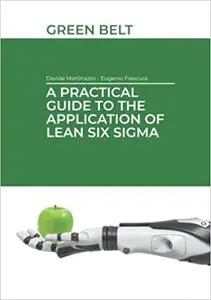Davide Martinazzo, Eugenio Frescura, "A Practical Guide to the application of Lean Six Sigma: Green Belt"
English | 2021 | ASIN: B09JWHFKQ6, B09LGLM6CK | EPUB | pages: 485 | 14.3 mb
English | 2021 | ASIN: B09JWHFKQ6, B09LGLM6CK | EPUB | pages: 485 | 14.3 mb
Description
This manual draws upon many years of direct experience in the management of improvement projects and training as Lean Managers in companies operating across various sectors (eg. Automotive, Electronics, Mechanical, Chemistry, Logistics). It presents the main tools of Lean Thinking and Six Sigma in order to make them applicable immediately in the management of quality and continuous improvement process both in production and in office environments, integrating within it concrete experiences and "tricks of the trade” that are not usually addressed in other reference texts.
Lean-Six Sigma evolved from the integration of Toyota Production System and Six Sigma, born in Motorola and developed in General Motors. It is an approach involving all resources that provides for small and continuous improvements aimed at reducing waste, ensuring sustainability and pervasiveness in the company, combined with a scientific approach that uses refined statistical tools aimed at achieving substantial improvements that would be difficult to achieve otherwise.
In addition to being packed with practical and concrete examples based on experiences in the field, the manual shows step-by-step development of numerous analyses using Excel and Minitab and aims to be a tool of practical consultation in the company supporting Green Belts in their daily work, as well as being the basis for the achievement of LSSGB certification (Lean Six Sigma Green Belt).
The manual considers the main tools of Lean Thinking and Toyota Production System such as the 5S, PDCA, A3 for problem solving, the Kanban system, the Value Stream Map (VSM) for process mapping, SMED for the reduction of machine tooling time, visible planning for the management of improvement projects, the Pareto digram.
Some of the tools covered in Six Sigma and industrial statistics are, for example, control charts, process capability, Measurement System Analysis (MSA), normal distribution, data analysis and graphical representation, DMAIC as a method for project management.
The chapters of the handbook retrace and deepen the contents of the Lean Six Sigma Green Belt certification path accredited by the Council for Six Sigma Certification and compliant with the ISO 13053:2011 Standard.
To Whom It Is Addressed
The manual is written in such a way that the tools within it can be adapted to the environment of small businesses, service companies and large multinational groups. It is aimed at production managers, plant managers, quality managers, process engineers, technologists and all resources that want to address the issue of continuous improvement, kaizen improvement and industrial statistics, as well as those who intend to undertake the Lean Six Sigma Green Belt certification.
Chapters of the text
Lean and Six Sigma, The 5 Lean Principles, The seven wastes, Poka Yoke, VOC - Voice of the Customer, SIPOC - Supplier, Input, Process, Output, Customer, The PDCA (Plan-Do-Check-Act), Problem solving tools, A3 as a tool for problem solving and project management, DMAIC and Project Charter, Team Working, Basic statistics, The Normal or Gaussian Distribution, Sampling methods, Data collection, stratification and graphical representation, Work Sampling, The 5S, Kanban, Machine performance indicators, SMED - Single Minute Exchange of Die, Value Stream Map and selection of product families, Hypothesis testing (Hp Test), MSA - Measurement System Analysis, Gage R&R - measuring the Reproducibility and Repeatability of a measurement method, Control Charts, Process Capability - Cp and Cpk, Visible planning for project management.



